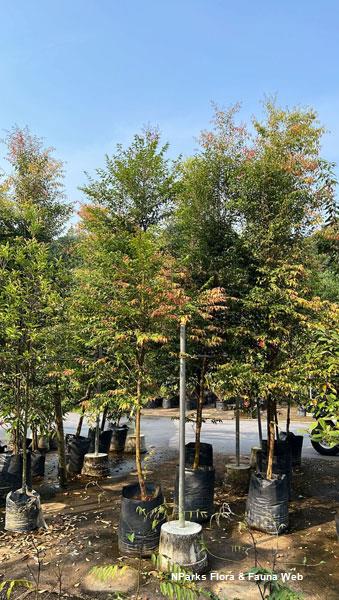
Back
Syzygium luehmannii (F.Muell.) L.A.S.Johnson
| Family Name: | Myrtaceae |
| Synonyms: | Syzygium leuhmannii (common misspelling) |
| Common Name: | Small-Leaved Lilly Pilly, Riberry, Cherry Satinash |
Name
Classifications and Characteristics
| Plant Division | Angiosperms (Flowering Seed Plants) (Dicotyledon) |
|---|---|
| Plant Growth Form | Tree (Medium (16m-30m), Small (6m-15m)) |
| Lifespan (in Singapore) | Perennial |
| Mode of Nutrition | Autotrophic |
| Maximum Height | 10 m to 30 m |
Biogeography
| Native Distribution | New Guinea, Australia |
|---|---|
| Native Habitat | Terrestrial (Riverine) |
| Preferred Climate Zone | Sub-Tropical / Monsoonal |
Description and Ethnobotany
| Others - Plant Morphology | Growth Form: Medium-sized evergreen tree with a dense, narrow crown and buttress roots. Although forest trees grow up to 30 m tall, cultivated plants typically reach a height of 5 - 10 m. Habitat: Occurs in subtropical rainforests. Also found near streams and rivers in scrubland. Trunk: Smooth branches are greyish to light brown. Foliage: Opposite, dark green leaves are elliptic to lanceolate with entire leaf margin (2 - 5 cm long). Young foliage is bright pink. Flowers: Cream-coloured to white flowers have 4 - 5 petals. Fruits: Bright pink to red, fleshy berries are approximately round to ellipsoid (1 - 1.5 cm long, 0.9 - 1.2 cm wide). Landscaping: This species produces attractive pinkish fruits and young leaves. It is often planted in home gardens and parks as a low hedge or topiary. Although it is a popular roadside tree in southeast Queensland (Australia), the abundant fruit production could cause a litter problem. It is also suitable for planting in large containers. This species is usually not attacked by psyllids which can cause lumps known as galls to form on leaves. Thus, it is a good substitute for Syzygium australe and its cultivars which are susceptible to gall-forming psyllids. Cultivation: This species grows best in fertile, well-draining soil that is kept moist. Plants may droop when grown in compacted or waterlogged soils. The crown is naturally narrow, but can be pruned to the desired shape. Propagation: Propagate by seed or stem cuttings. Etymology: The genus name "Syzygium" is derived from the Greek word "suzugos" which means joined. Syzygium used to be the name of a Jamaican plant species with paired leaves and branches. |
|---|---|
| Ethnobotanical Uses | Edible Plant Parts : Edible Fruits Food (Fruit or Vegetable) Others: Food: Edible fruits have a clove- and cinnamon-like taste. They are added to ice cream, cakes, pies, jams and meat-based sauces. |
Landscaping Features
| Desirable Plant Features | Ornamental Foliage, Ornamental Fruits |
|---|---|
| Landscape Uses | Swimming Poolside, Hedge / Screening, Topiary, Container Planting |
| Thematic Landscaping | Economic Garden |
Plant Care and Propagation
| Light Preference | Full Sun |
|---|---|
| Water Preference | Moderate Water |
| Plant Growth Rate | Moderate |
| Rootzone Tolerance | Fertile Loamy Soils, Well-Drained Soils |
| Propagation Method | Seed, Stem Cutting |
Foliar
| Foliage Retention | Evergreen |
|---|---|
| Mature Foliage Colour(s) | Green |
| Mature Foliage Texture(s) | Smooth, Glossy / Shiny |
| Prominent Young Flush Colour(s) | Pink |
| Foliar Type | Simple / Unifoliate |
| Foliar Arrangement Along Stem | Opposite |
| Foliar Shape(s) | Non-Palm Foliage (Lanceolate, Elliptical) |
| Foliar Venation | Pinnate / Net |
| Foliar Margin | Entire |
| Foliar Apex - Tip | Acute |
| Foliar Base | Acute |
| Typical Foliar Area | Microphyll ( 2.25cm2 - 20.25 cm2 ) |
Non - Foliar and Storage
| Trunk Type (Non Palm) | Woody |
|---|---|
| Root Type | Underground (Tap Root) |
Floral (Angiosperm)
| Flower & Plant Sexuality | Bisexual Flowers |
| Flower Colour(s) | Cream / Off-White, White |
|---|---|
| Flowering Habit | Polycarpic |
Fruit, Seed and Spore
| Mature Fruit Colour(s) | Pink, Red |
|---|---|
| Fruit Classification | Simple Fruit |
| Fruit Type | Fleshy Fruit , Berry |
Image Repository
Others
| Master ID | 30558 |
|---|---|
| Species ID | 4867 |
| Flora Disclaimer | The information in this website has been compiled from reliable sources, such as reference works on medicinal plants. It is not a substitute for medical advice or treatment and NParks does not purport to provide any medical advice. Readers should always consult his/her physician before using or consuming a plant for medicinal purposes. |



.jpg)

